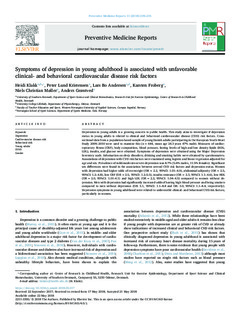| dc.contributor.author | Klakk, Heidi | |
| dc.contributor.author | Kristensen, Peter Lund | |
| dc.contributor.author | Andersen, Lars Bo | |
| dc.contributor.author | Froberg, Karsten | |
| dc.contributor.author | Møller, Niels Christian | |
| dc.contributor.author | Grøntved, Anders | |
| dc.date.accessioned | 2018-11-01T12:44:10Z | |
| dc.date.available | 2018-11-01T12:44:10Z | |
| dc.date.created | 2018-10-11T14:23:50Z | |
| dc.date.issued | 2018 | |
| dc.identifier.citation | Preventive Medicine Reports. 2018, 11, 209-215. | nb_NO |
| dc.identifier.issn | 2211-3355 | |
| dc.identifier.uri | http://hdl.handle.net/11250/2570620 | |
| dc.description | This is an open access article under the CC BY-NC-ND license (http://creativecommons.org/licenses/BY-NC-ND/4.0/). | nb_NO |
| dc.description.abstract | Depression in young adults is a growing concern to public health. This study aims to investigate if depression status in young adults is related to clinical and behavioral cardiovascular disease (CVD) risk factors. Cross-sectional data from a population-based sample of young Danish adults participating in the European Youth Heart Study 2009–2010 were used to examine this (n = 644, mean age 24.3 years 47% male). Measures of cardiorespiratory fitness (CRF), body composition, blood pressure, fasting levels of high and low density lipids (HDL, LDL), insulin, and glucose were obtained. Symptoms of depression were obtained using the Major Depression Inventory scale. Information on sleep disorders; drinking and smoking habits were obtained by questionnaires. Associations of depression with CVD risk factors were examined using logistic and linear regression adjusted for age and sex. Prevalence of mild-moderate-severe depression was 8.7% (5.6% males, 11.5% females). Significant sex differences were found in the association between several CVD risk factors and depression status. Women with depression had higher odds of overweight (OR = 2.2, 95%CI: 1.01–4.0), abdominal adiposity (OR = 2.5, 95%CI: 1.2–4.8), low CRF (OR = 2.5, 95%CI: 1.2–5.5), insulin resistance (OR = 2.3, 95%CI: 1.1–4.6), low HDL (OR = 2.0, 95%CI: 1.01–4.1) and high LDL (OR = 2.2, 95%CI: 1.04–4.5) compared to women without depression. Men with depression had significantly increased odds of having high blood pressure and being smokers compared to men without depression (OR: 3.1, 95%CI: 1.1–8.8 and OR: 3.0, 95%CI: 1.1–8.4, respectively). Depression symptoms in young adulthood were related to unfavorable clinical- and behavioral CVD risk factors, particularly in women. | nb_NO |
| dc.language.iso | eng | nb_NO |
| dc.subject | depression | nb_NO |
| dc.subject | cardiovascular disease risk | nb_NO |
| dc.subject | behavioral risk | nb_NO |
| dc.subject | young adults | nb_NO |
| dc.subject | eyhs | nb_NO |
| dc.subject | gender | nb_NO |
| dc.title | Symptoms of depression in young adulthood is associated with unfavorable clinical- and behavioral cardiovascular disease risk factors | nb_NO |
| dc.title.alternative | Symptoms of depression in young adulthood is associated with unfavorable clinical- and behavioral cardiovascular disease risk factors | nb_NO |
| dc.type | Journal article | nb_NO |
| dc.type | Peer reviewed | nb_NO |
| dc.description.version | publishedVersion | nb_NO |
| dc.rights.holder | © 2018 The Authors. | nb_NO |
| dc.source.pagenumber | 209-215 | nb_NO |
| dc.source.volume | 11 | nb_NO |
| dc.source.journal | Preventive Medicine Reports | nb_NO |
| dc.identifier.doi | 10.1016/j.pmedr.2018.05.017 | |
| dc.identifier.cristin | 1619728 | |
| dc.description.localcode | Seksjon for idrettsmedisinske fag / Department of Sports Medicine | nb_NO |
| cristin.unitcode | 150,34,0,0 | |
| cristin.unitname | Seksjon for idrettsmedisinske fag | |
| cristin.ispublished | true | |
| cristin.fulltext | original | |
| cristin.qualitycode | 1 | |
